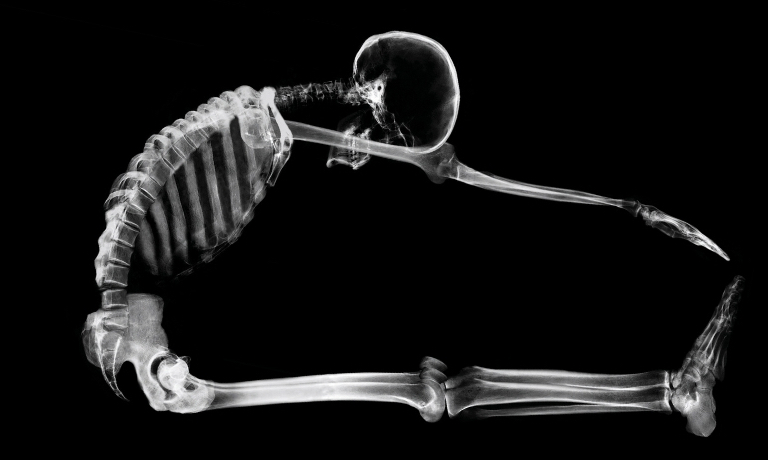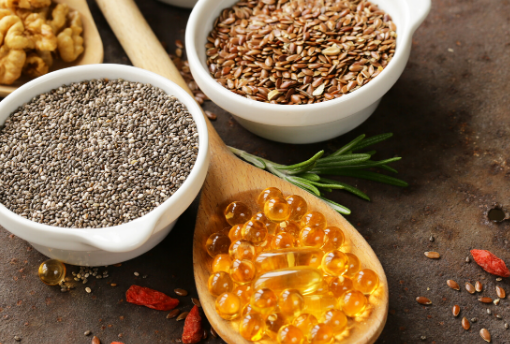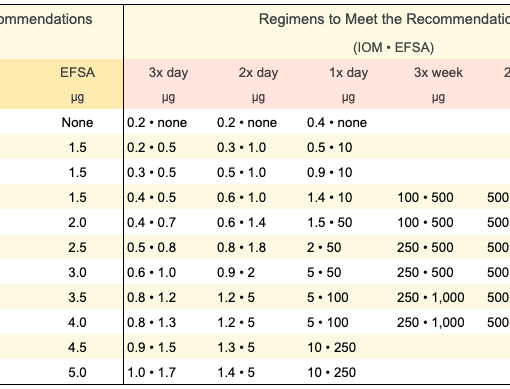
by Jack Norris, RD
After sending out Friday’s post, I realized that there’s a counterpoint to a lack of whole foods not playing a role in the higher fracture rates of vegans in EPIC-Oxford. β-carotene is the one nutrient for which I think there’s plausible evidence for impacting the fracture rates to a meaningful degree (see the section on β-carotene below). The RDA is 700 retinol activity equivalents (RAE) for women and 900 for men. The food highest in β-carotene is carrot juice which contains about 1,140 RAE per 1/2-cup; carrot juice may or may not fit one’s definition of a whole food. There are also processed foods such as sweet potato fries (274 RAE per cup) and pumpkin pie (about 100-150 RAE per slice) which contain fat that can aid the absorption of β-carotene. But the most common way to obtain β-carotene is through whole foods such as carrots (509 RAE per medium carrot), sweet potatoes (595 RAE per 1/2 medium), and spinach (472 RAE per 1/2-cup cooked). See Vitamin A for more foods.
In Part 2 below:
- Body Mass Index and Caloric Intake
- β-carotene and Vitamin A
I had also promised Zinc in this post but it got too long. The entire article is Bone Fractures among U.K. Vegans: Implications and Recommendations.
Abbreviations: HR–hazard ratio • IRR–incidence rate ratio • n–number of people • SD–standard deviation
Body Mass Index and Caloric Intake
As mentioned in the introduction, right away, we know that the increased rate of fracture among vegans in this study is largely driven by women and those with a lower body mass index (BMI). This could lead us to think that a higher proportion of women with eating disorders are deciding to be vegan and that these women are more likely to have fractures.
The Centers for Disease Control and Prevention considers a BMI of 18.5 to 24.9 to indicate a “normal or healthy weight” (CDC, 2020). In EPIC-Oxford, the average BMI of vegans at baseline was 21.9 (SD 3.0) for women and 22.5 (SD 3.0) for men, compared to 24.3 (SD 4.2) and 24.9 (SD 3.3) for meat-eaters, respectively (Tong, 2020).
A 2014 meta-analysis of 25 cohort studies looking at body mass index (BMI) and bone fractures in women found that a BMI >30 is associated with a significant, modest reduction in fracture risk (Johansson, 2014). This appears to be due to a higher bone mineral density, as once bone mineral density is adjusted for the risk of fracture increases with a higher BMI. Figure 1 in the paper shows that as BMI decreases from about 22.5 to 15, the rate of fracture, especially hip fracture, increases exponentially.
So far, this research is consistent with what was found among vegans in EPIC-Oxford: Low BMI is associated with an increased risk of hip fractures.
A more recent prospective, observational study from the Nurse’s Health Study examined associations between BMI, waist circumference, and vertebral fracture risk among females with a follow-up time of about 12 years (Paik, 2019). The average BMI in the lowest quintile was 19.8 (SD 1.1) and was not associated with an increased risk of fracture.
There isn’t a lot of data on bone fractures in people with a very low BMI. A Danish study used a case-control method to follow women with eating disorders for 19.3 years (Frølich, 2020). Women with less severe cases of anorexia nervosa (n=230) had an average lowest BMI of 15.5 and a higher risk of all fractures than healthy controls (IRR 1.7, CI 1.1-2.7), but not a higher risk of hip fractures (IRR 2.9, CI 0.4–12.3). Those with a more severe case of anorexia nervosa (n=194) had an average nadir BMI of 14.4 and a much greater risk of all fractures (IRR 2.6, CI 1.8-3.7) and hip fractures (IRR 9.8, 3.6-27.7). Women with a less severe form of bulimia nervosa (n=170) had an average nadir BMI of 18.7 with no significantly elevated risk of fractures.
As with the vegans in EPIC-Oxford with a low BMI, the Danish women with severe cases of anorexia nervosa had high rates of hip fractures, but their BMI was likely much lower than the vegans in EPIC-Oxford. If the BMI for vegans is assumed to be normally distributed, then about 34% had a BMI between 18.9 and 21.9 (n=430), while about 13.5% had a BMI between 15.9 and 18.9 (n=171). The Danish women with average nadir BMIs closer to the likely BMIs of vegans in EPIC-Oxford didn’t have a higher rate of fracture.
I wrote Dr. Tammy Tong of EPIC-Oxford asking about the possibility that very low BMIs among a small percentage of vegans drove the majority of the increased risk and she responded that this was not a likely explanation, saying “For BMI and calcium, the choice of categories were driven both by the distribution of data across all dietary groups, and also after being assured that the main associations could not be driven by the extreme categories, which we checked for in preliminary analyses.”
Synthesizing the above information would suggest that although having a lower BMI was associated with a higher fracture rate in vegans, there isn’t evidence that it’s due to a high rate of disordered eating. This conclusion might be hard to follow, so I want to explain it a bit more. Women with eating disorders so severe that they result in higher rates of fracture, especially hip fracture, have BMIs on average lower than the BMIs of the vegan women in EPIC-Oxford on the lower end of the BMI spectrum (as predicted by a normal distribution). This isn’t to say that the vegans in EPIC-Oxford didn’t have a higher rate of eating disorders than the meat-eaters, but rather that even if they did have a higher rate of eating disorders, their general BMIs aren’t as low as the average BMIs in women with eating disorders who have higher rates of fracture (compared to healthy controls). So there is likely something else about being vegan (with or without an eating disorder) that is driving the higher rate of fracture among vegans.
In addition to disordered eating, a variable that would obviously be correlated with low BMI is lower caloric intake. In Table S5, EPIC-Oxford reports fracture rates adjusted for caloric intake which showed a similar total fracture rate for vegans (HR 1.42, CI 1.19-1.69) as the rate not adjusted for caloric intake from Table 2 (HR 1.30, CI 1.08-1.56). However, in the model adjusted for caloric intake, they also adjusted for BMI which would likely ameliorate any strong finding for caloric intake alone.
We can’t rule out that lower bone health could be a result of lower caloric intake, possibly leading to lower vitamin or mineral intakes among vegans.
β-carotene and Vitamin A
Preformed versions of vitamin A, known as retinoids, can be provided by animal products in the diet, whereas plant products provide the precursors to vitamin A, with the primary precursor being β-carotene. The body more tightly regulates vitamin A levels when it’s derived from precursors than when ingested as preformed vitamin A (Wu, 2014). There are a variety of theoretical ways in which too much or too little vitamin A could impact bone health (Zhang, 2017) and the research has found a variety of associations in different directions.
In their meta-analysis of 13 prospective, observational studies on vitamin A and fractures, Zhang et al. (2017) found that higher total vitamin A or retinol intake might slightly decrease the risk of total fracture but increase the risk of hip fracture. They also found that higher β-carotene intake slightly increases the risk of total fracture but not hip fracture. They observed a weak but positive influence of lower blood retinol levels on both total and hip fracture risk. They didn’t provide either intake or plasma retinol amounts, making it hard to compare with those of vegans.
Wu et al. (2014) conducted a similar meta-analysis on an almost-identical set of studies as Zhang et al. and found an increased rate of bone fracture at both the high and low ends of plasma retinol level. They calculated the optimal blood retinol level to be 1.99 to 2.31 µmol/l. They write:
The clinical implication of this study is that blood retinol level is a double-edged sword for the risk of hip fracture. To avoid the risk of hip fracture caused by too low or too high a level of retinol concentration, we suggest that intake of beta-carotene (a provitamin A), which is mainly from plant-based foods and should be converted (through a process adjusted by a feedback mechanism) to retinol in the blood, may be better than retinol from meat (fish, liver, poultry, or dairy foods), which will be directly absorbed into the blood after intake.
In EPIC-Oxford, after 5.2 years of follow-up, there was no association between retinol intake and bone fractures, or between β-carotene intake and fractures (Key, 2007). There was no separate analysis for vegans. The earliest nutrient intake report from EPIC-Oxford didn’t include β-carotene (Davey, 2003).
A follow-up survey from EPIC-Oxford, conducted in 2010, found vegans to have β-carotene intakes of 451 RAE/day for women and 432 RAE/day for men, well below their respective DRIs of 700 RAE and 900 RAE (Sobiecki, 2016).
Of three studies measuring blood retinol levels of vegans (which weren’t part of EPIC-Oxford, see the table below), one study found levels to be slightly higher than recommended by Wu et al., while the other two studies found them to be lower. Note that Wu et al.’s blood retinol recommendations are for a much smaller range than what’s considered normal and that vegans fall well within the normal reference ranges listed in the table below. The range of β-carotene intakes of vegans in Li et al. and Schüpbach et al. were quite wide such that many vegans were likely not meeting the DRI.
The table shows that vegans who eat more β-carotene than those in EPIC-Oxford had retinol levels lower than what Wu et al. recommend. It, therefore, seems possible that low β-carotene intakes among EPIC-Oxford vegans could have contributed to higher fracture rates.
It’s easy for most vegans to get enough β-carotene through common, whole foods such as carrots, but if you neglect such foods it’s possible to be quite low (see Daily Needs: Vitamin A for sources and amounts). It’s best to consume food sources of β-carotene with fat for optimal absorption.
In Part 3:
- Zinc
- Iodine
- Selenium
References
Johansson H, Kanis JA, Odén A, McCloskey E, et al. A meta-analysis of the association of fracture risk and body mass index in women. J Bone Miner Res. 2014 Jan;29(1):223-33. Erratum regarding author affiliation.






4 thoughts on “Bone Fractures among U.K. Vegans: Part 2”
Have you considered that pregnancy and lactation are one major factor that can protect against fractures in women? Also, some statistics say that a lot of vegan women do not have children, so they could miss out on this protection.
The higher percentage of vegan women without children could be driving up the numbers against their omnivore counterparts.
I heard this argument from Mic the Vegan in his analysis. What do you think about it?
Carl,
The EPIC-Oxford results were adjusted for “parity (none, 1–2, ≥ 3, unknown)”. Breastfeeding wasn’t mentioned and I haven’t looked into that. A quick search (just now) for breastfeeding and fractures didn’t reveal a lot of research, but I found this “Although breastfeeding for 12 months or longer was associated with a higher risk of any fractures (aHR, 1.05; 95% CI, 1.03-1.08) and vertebral fractures (aHR, 1.22; 95% CI, 1.17-1.27), it was associated with a lower risk of hip fracture (aHR, 0.84; 95% CI, 0.76-0.93)” (link).
Based on this small amount of info I wouldn’t think that breastfeeding is a likely explanation for the difference in total fractures in EPIC-Oxford. I say this because of the different directions the association points to in the study above and because the majority of adjustment in EPIC-Oxford for breastfeeding likely occurred when adjusting for parity.
Here is the study from Mic‘s video. Breastfeeding reduced the risk of hip fractures by 50%. So if vegan women in the study were younger or had less children then their omnivore counterpart this might impact the results:
https://asbmr.onlinelibrary.wiley.com/doi/pdf/10.1002/jbmr.496
He also points out that men did not have more fractures, which again makes a case for the breastfeeding theory.
Kind regards from Vienna!
Here is the link to his video, you can delete this part from the comment, if you don‘t want to publish a link to Youtube: https://youtu.be/B3qxQFFLFt8
Carl,
The study by Bjørnerem et al. definitely had a stronger finding in favor of breastfeeding (based on the abstract). Since EPIC-Oxford adjusted for parity, it seems like vegans with children would have to be less likely to breastfeed than meat-eaters for breastfeeding to have impacted the results. I can’t recall any research measuring breastfeeding rates in vegans vs. meat-eaters, but I don’t see a reason to believe vegans with children breastfeed less.